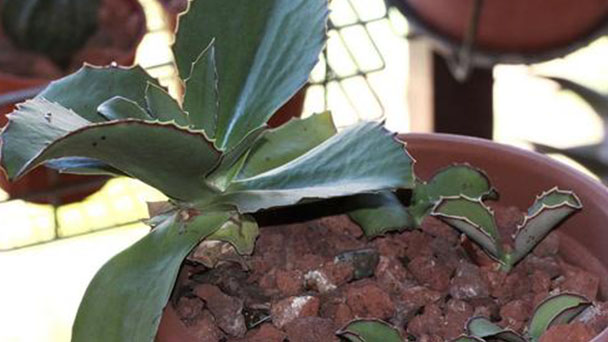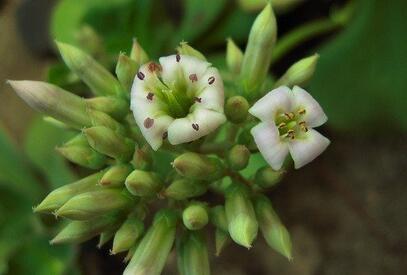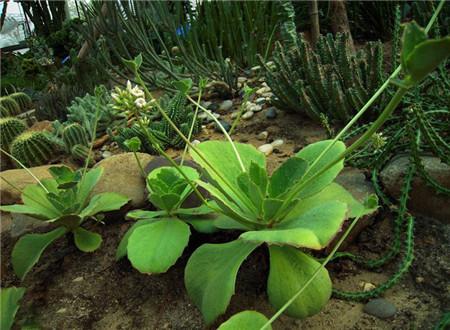Walking kalanchoe (Kalanchoe synsepala) profile
Written by Maggie
Oct 14 2021

Walking Kalanchoe, scientific name Kalanchoe synsepala, is mainly located in southeast Africa, on the island of Madagascar. Walking Kalanchoe is suitable for potted plants and plants in indoor cultivation.
Walking Kalanchoe Picture

Walking Kalanchoe Characteristics
Walking Kalanchoe Stems
Walking Kalanchoe (Kalanchoe synsepala) has a short stem.
Walking Kalanchoe Leaf
Leaves of walking kalanchoe are fleshy, opposite ovate, short stipulate, 6 -- 14 cm long and 4 -- 6 cm wide with serrated margins.Leaves grayish green reddish with red margins.
Walking Kalanchoe Flowers
Walking Kalanchoe is a long, thin stalk drawn from the axil of the leaf. The floret hangs bell-shaped and is yellow-green. Interestingly, when the Walking Kalanchoe reaches a certain size, long thin stolons (stolons) will come out from the axils of the leaves. At the top of each stolon will come adventitious buds that look like butterflies. These adventitious buds will soon develop into small plants with roots.
Walking Kalanchoe: Flowers in winter and spring.
Walking Kalanchoe Native Habits
Ideal for warm, dry and sunny environments. Walking Kalanchoe (Kalanchoe synsepala) is resistant to drought and semi-shade. Able to low temperatures and standing water. It is not suitable to water too much in cultivation, so as not to cause root rot because the basin soil is too wet, but can spray water to the foliage when the air is dry, midsummer and winter should be more strictly controlled watering. In summer Walking Kalanchoe needs appropriate shade, in case of scorching sun insolation, but also cannot too shade, with the light is bright, without direct sunlight is better. Because the light is insufficient, which can make the leaf soft, deformation, not straight and straight, leaf color also turns dark yellow, affecting the beauty of plant form directly.
In addition, the summer high temperature should also strengthen ventilation, in order to prevent the sultry environment damage to the Walking Kalanchoe. The rest of the year gets as much sunlight as possible. During the growing period, thin liquid fertilizer should be applied once a month. When applying fertilizer, the liquid should not be splashed on the leaves, so as not to appear ugly spots.
Keep Walking Kalanchoe indoors in front of a sunny window for maintenance in winter and keep it above 5℃ for a safe winter. The Walking Kalanchoe should be replaced in the spring every year, and the pot soil should be loose and fertile sandy loam.
Walking Kalanchoe Care
Walking Kalanchoe comes from Southern Africa. Walking Kalanchoe likes a warm, dry and sunny environment. Walking Kalanchoe is afraid of low temperature and water, drought resistance and half shade. Walking Kalanchoe prefers fertile and well drained acid sandy loam. The temperature in winter is not lower than 10℃.
Walking Kalanchoe mainly propagate with branching and cuttings. Stolons grow from the top of the stem. Walking Kalanchoe comes adventitious buds resembling butterflies. The adventitious buds of butterfly shape can be cut off and potted directly throughout the year. Cuttage, in 5-6 months, will be mature and substantial leaves cut, to be cut into the sand bed after dry, inserted soil with slightly dry as well. After 20-25 days can take root, gradually grow plantlets.
Watering
Water should not be overdone in order not to rot the roots because the soil in the pot is too wet. However, water should be sprayed on the foliage when the air is dry. Watering should be strictly controlled in the middle of summer and winter.
Light
In summer Walking Kalanchoe (Kalanchoe synsepala) needs appropriate shade, in case of scorching sun insolation, but also cannot too shade, with the light is bright, without direct sunlight is better. Because of the lack of light, Walking Kalanchoe's leaves are soft, distorted and not straight. The leaves also turn dark yellow, which affects the beauty of the tree shape.
Ventilation
Ventilation is also needed during high temperatures to prevent damage to the Walking Kalanchoe (Kalanchoe synsepala). The rest of the year gets as much sunlight as possible.
Fertilizer
Apply thin liquid fertilizer once a month during the growing season. Be careful not to splash the liquid on the leaves to avoid unflattering spots.
Temperature
In winter, put Walking Kalanchoe indoors in front of a sunny window for maintenance and keep it above 5℃ for a safe winter. Repot the Walking Kalanchoe plant every spring. Use loose, fertile sandy loam soil for the pot.

Walking Kalanchoe Propagation
By cutting adventitious shoots from the top of the Walking Kalanchoe (Kalanchoe synsepala) and planting them directly into pots, you can do this all year round but it works best in spring and fall. It can also be in 5 ~ June for leaf insertion, the method is to mature substantial leaves cut off, slightly air 2 ~ 3 days, to be inserted into the sand after the incision dry, after maintaining a little moisture, 20 ~ 25 days can take root, and gradually grow small plants, such as small plants a little larger, can be transplanted on the pot.
Walking Kalanchoe is strangely shaped. The symmetrical leaves are wide and glossy with a bright red at the edge and the small plants at the top of the stolons look more like butterflies.
Walking Kalanchoe Disease Control
Leaf blight
Walking Kalanchoe is mainly liable to leaf blight and can be sprayed with 65% Dessen Zinc WP 600 times.
Pest control
Walking Kalanchoe damage from mealworms and scale insects. Spray with 50% boretinx emulsion 1500 times.
Walking Kalanchoe Distribution
Walking Kalanchoe comes from the island of Madagascar in southeast Africa.
Walking Kalanchoe (Kalanchoe synsepala) is mainly located in southeast Africa, on the island of Madagascar.
Walking Kalanchoe Use
If you use potted plants to decorate the windows, cabinet tops, desks or directly use hanging pots to decorate the indoor environment, it gives a fresh, elegant, vivid and interesting feeling and is very popular with people.
Walking Kalanchoe is very popular because it's suitable for potted and brandy plants to grow indoors.

Latest Updated
- Benefits of Bugleweed - 7 Science-backed Health Benefits
- Bugleweed Dangers & Side Effects - Is It Poisonous?
- How to Plant Evergreen Trees - What You Should Know
- When to Plant Evergreens - Grow Guide for Evergreen Trees
- 12 Wonderful Evergreen Shrubs for Your Garden
- 12 Popular Evergreen Plants with Pictures for Beginners
- When And How To Prune A Lilac Bush Like a Pro
- How to Grow & Care for Lilac Vine (Hardenbergia Violacea)
- Japanese Lilac Tree (Syringa Reticulata) Care & Propagation Guide
- Shumard Oak Pros and Cons - What to Know
Popular Articles
- Winter maintenance of Antirrhinum Majus
- How to Grow Terminalia Mantaly Tree
- How to Grow and Care for Crossostephium Chinense
- How to grow Antirrhinum Majus in spring
- Peristeria Elata (Dove Orchid) Profile: Info & Care Guide
- Underwatered Snake Plant (Sansevieria Trifasciata) - Signs And How To Fix
- How to Care for Brazilian Jasmine Plant (Mandevilla Sanderi)
- How to Grow & Care for Graptopetalum Purple Delight in Summer
- Rosa Chinensis (China Rose): Plant Growing & Care Tips
- How to Care for Baby Sun Rose (Aptenia Cordifolia)